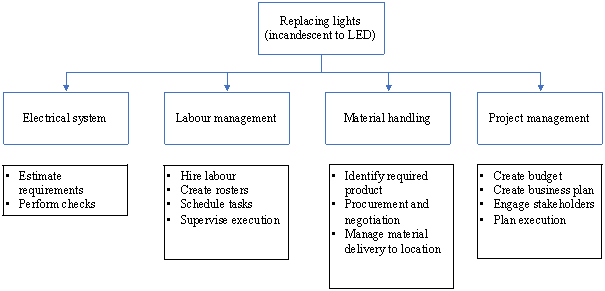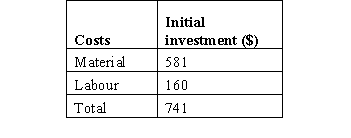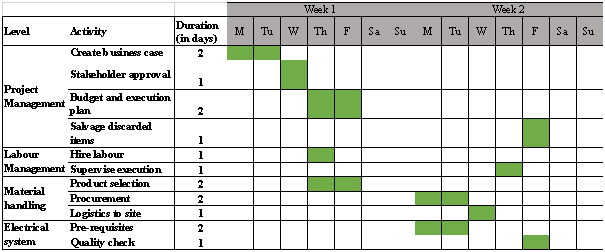Project Management Assignment: Replacement of 100 watt bulbs with LED by APIC Project Development & Optimisation Pty Ltd
Question
Task: In this project management assignment, you are required to choose a decision-making situation about a project. The student needs to study the literature and find the best practice to analyses the situation with rationale. The team is required to focus on cost consideration, project delivery and execution from the perspective of sustainability, estimate cash-flow items both inflows and outflow for each alternative. The bases of estimations for estimates should be given. The team needs to decide about interest rate, project life, and other parameters that can affect economic analysis in this activity and apply one of the techniques to evaluate each alternative and select the best one.
The student should finalize results of their last part of this assessment and conduct a sensitivity analysis for the case project. For sensitivity analyses, parameters should be selected, and scenarios of sensitivity analyses should be defined accordingly. For each scenario, the economic analysis should be done, and results should be compared and explained. The student should also provide parameters for due diligence processes and the information needs of stakeholders and supporters of the project.
Answer
1. Executive Summary
APIC Project Development & Optimisation Pty Ltd, selected in this project management assignment, is evaluating several projects on sustainability to comply with the Australian government’s focus on renewable energy and sustainable living. Australia released about 830m tonnes of carbon dioxide (Morton, 2020) in the last bushfire season,which was more than the annual greenhouse emission of the country. Australia is amongst the top nations when it comes to yearly emission. Organizations need to prioritize the agenda of sustainable living and undertake projects to achieve it.
A reduction in energy consumption could be a top priority, traditionally office spaces have been fitted with incandescent bulbs. Several studies in the area of lightning have suggested the economic benefit of replacing these lights (Ganandran et al., 2014). LED lights are recommended for office space, based on economic analysis of LED lighting vs. incandescent lighting on qualitative and quantitative factors. If taken up, the project has a high net present value on a 10-year horizon (the lifespan of one LED light).
Such a project can be completed in a short span of 2-weeks. Stakeholders include the project manager, the electrical systems team, material handling department and human resource. Project should be taken up immediately, as the project IRR is high at 588% (based on assumptions outlined in the report).
2. Introduction
APIC Project Development &Optimisation Pty Ltd wants to evaluate replacement of 500 lights of 100w (incandescent) with energy efficient LED lights. This project has two objectives – a) achieve a part of its sustainability goal and b) reduce the overall carbon footprint of the organization.
Sustainability as a conceptis based onthree constraints that apply to human activities (Clift, 2007) –
i. Eco-centric concerns, which stems from the fact that earth is a closed system with finite resources.Its capacity to absorb emissions from human activities is limited
ii. Techno-centric concerns i.e. our technology capabilityis limited
iii. Socio-centric concerns, as we want to live a certain standard of life and ensure that future generations also experience a similar or better living standard
Thus, humans should scrutinize every macro-activity. Decisions should be aimed at eithereliminating the non-sustainable activities orfinding an alternative.
Immediate need to consider sustainability is felt more so in a few sectors e.g. energy, property development, mining sectors. When the Australian National Electricity Market opened up, maintaining sustainable emission level was not part of the agenda(Nelson et al., 2019). Ever since, a national climate change policy framework has been missing. There is limited incentive for companies toreducetheir carbon emissions.
There are a few simple measures that an organization can take towards sustainable living. One of them is replacing the high wattage light bulbs with the more efficient LED lights. There are several disadvantageswith the traditional light bulbs e.g. they emit high radiant heat (Singh, Basu, Meinhardt-Wollweber and Roth, 2015). Whereas, LED (light-emitting diodes) lights are energy efficient, don’t require frequent replacement and have low maintenance cost.
3. Work breakdown structure
The primary activity of this project is replacement of 500 incandescent lights with LED lights. Work breakdown structure (WBS) is depicted in Figure 1. This structure has three levels, the second level includes functional tasks like electrical systems management, labour, project management and material handling. Third level lists breakdown of tasks for each of the functions. For a successful execution, these functions should be aligned to the primary objective. It is the responsibility of project manager tocommunicate timeline and instructions on delivery to all stakeholders.

Figure 1 Work breakdown structure
4. Evaluation parameters and cost considerations
Evaluation of the project of replacing 100 watt bulbs (500) with LED includes a number of considerations and assumptions, these are listed below –
4.1. Quantitative factors
4.1.1. Comparison between LED and 100w incandescent lights on various parameters
• Brightness
The brightness of light bulbs is measured in lumens. A 100 watt incandescent bulb gives 1600 lumens (Lumens and the Lighting Facts Label, 2020) i.e. 16 lumens per watt. Whereas, a 14 watt LED light gives similar brightness i.e. 114 lumens per watt (LED Light Bulbs: Comparison Charts, 2020)
Assumption – brightness of the space will remain constantafter replacement, thus, quantity of LED lights required is 70
• Lifespan
LED lights can work for 25,000 hours, whereas light bulbs need replacement after 1,250 hours (LED Light Bulbs: Comparison Charts, 2020)
Assumption –Office space is operationalfor 50 weeks every year, 5 days a week for 10 hours. Per year the lights are switched on for 2500 hours. The lease time of office space has been assumed to be 10 years
• Cost of light
An LED light costs higher than a light bulb, at $8.3 and $1.7 respectively (LED Light Bulbs: Comparison Charts, 2020) for the same amount of brightness
• Cost of electricity
Assumption – electricity tariff is assumed to be $0.1 per KWh
• Salvage value of replaced lights
Assumption –500 light bulbs being replaced have little market value. Assuming they are in working condition, the market value is estimated to be $0.5 per light
4.1.2. Cost and revenue structure for the activity to calculate savings
• Costs
o Labour cost – to change the light bulbs to LEDs
Assumption - 1 labour is hired for a day for this activity at $20/hour. Thus, initial investment of $160 required
o Material cost of lights – 500 light bulbs are replaced with 70 LED lights costing $8.33 each. Thus, initial investment of $541 required
Table 1 Costs for the project

• Revenue
o Energy savings due to new lights
a. 100w light consumes 0.1 KWh i.e. for 2500 hours of operational time every year, the consumption is of 250 KWh. The associated cost for 500 lights is $1250
b. LED light consumes 0.14 KWh i.e. for 2500 hours of operational time every year, the consumption is 35 KWh. Associated cost for 70 lights is $24.5
Thus, total saving is $1225.5 per year
o Savings due to greater lifespan of LED 1 LED light needs replacement once every 10 years, whereas, a light bulb needs replacement twice a year. The associated cost of new bulbs (1000 per year) is $1670 per year
o Scrap value of 100w lights
If the 100w lights are sold in the market in a working condition, a value of $250 can be recovered (one time)
Table 2 Revenue due to the project

4.2. Qualitative factors
A comparison of the two forms of lighting on qualitative factors of importance (LED Light Bulbs: Comparison Charts, 2020)
• Higher durability – LED lights
• Lower heat emission – LED lights
• Low sensitivity to temperature extremes – Incandescent lights
• Instant turn on – LED lights and incandescent lights
• Dimming light – feature available with LED lights
• Light colour – LED lights come in twomodes – white and yellow, those suitable for décor can be used
5. Economic Analysis and recommendation
The assumed rate of interest (2020) is same as outlined by Reserve Bank of Australia, 0.25%. This rate has been used for discounting. Various cost and revenue heads as calculated based on assumptions have been considered to create the P&L statement of the project. While there is no revenue from undertaking this project, there will be considerable saving on energy consumption and material cost (cost of replacing light bulbs at a higher frequency compared to LED)
Table 3 NPV calculation for economic analysis

The NPV of this project is very high $28,070 for a 10-year horizon. This indicates that the project should be taken up.
6. Cash-flow diagram
At present value of revenue (discounted at 0.25%)

Figure 2 Cash flow diagram based on present values
7. Sensitivity Analysis
Two input parameters – interest rate and salvage value of old bulbs, when altered to assess risk of the projects, result in four scenarios. For the first two scenarios, interest rate has been considered low at 0.25%, and salvage value has been changed. If the replaced lights don’t have any market value this scenario will help assess impact on project. Further, if the interest rate is considered very high (1000%) then the NPV value has been observed to become negative. This indicates that the project is robust and should be undertaken. The alternate scenario where NPV is negative is unlikely due to the interest rate factor.
Table 4 Sensitivity Analysis

8. Project implementation plan and stakeholder engagement
The work breakdown structure has been laid out with timeline to create thegantt chart, this should be regularly updated and shared with the relevant stakeholders. They should beapprised of the project progress. Stakeholders of the project are –
- Project manager’s team for planning and execution
- Top executives who sponsor the project
- Human resources to hire and supervise labour
- Procurement team for material handling
- Electrical systems team to communicate pre-requisites and perform quality checks

Figure 3 Gantt chart for project execution
9. Conclusion
The NPV of the project is positive for the initial scenario of 0.25% interest rate and $250 salvage value of old bulbs. This project is profitable as long as an alternate investment doesn’t exist which gives a return greater than 588% i.e. return > IRR. Scenarios where discount rate exceeds this value have a negative NPV. As the return on this investment is unmatched both on qualitative and quantitative considerations, it is recommended that this project is taken up for long term benefit of the organization.
10. References
1. Clift, R., 2007. Climate change and energy policy: The importance of sustainability arguments. Energy, 32(4), pp.262-268.
2. Eartheasy Guides & Articles. 2020. LED Light Bulbs: Comparison Charts. [online] Available at:
3. Energy.gov. 2020. Lumens And The Lighting Facts Label. [online] Available at:
4. Ganandran, G., Mahlia, T., Ong, H., Rismanchi, B. and Chong, W., 2014. Cost-Benefit Analysis and Emission Reduction of Energy Efficient Lighting at the UniversitiTenagaNasional. The Scientific World Journal, 2014, pp.1-11.
5. Morton, A., 2020. Summer's Bushfires Released More Carbon Dioxide Than Australia Does In A Year. [online] the Guardian.Project management assignment Available at:
6. Nelson, T., Pascoe, O., Calais, P., Mitchell, L. and McNeill, J., 2019. Efficient integration of climate and energy policy in Australia’s National Electricity Market. Economic Analysis and Policy, 64, pp.178-193.
7. Singh, D., Basu, C., Meinhardt-Wollweber, M. and Roth, B., 2015. LEDs for energy efficient greenhouse lighting. Renewable and Sustainable Energy Reviews, 49, pp.139-147.
8. Reserve Bank of Australia. 2020. [online] Available at:












